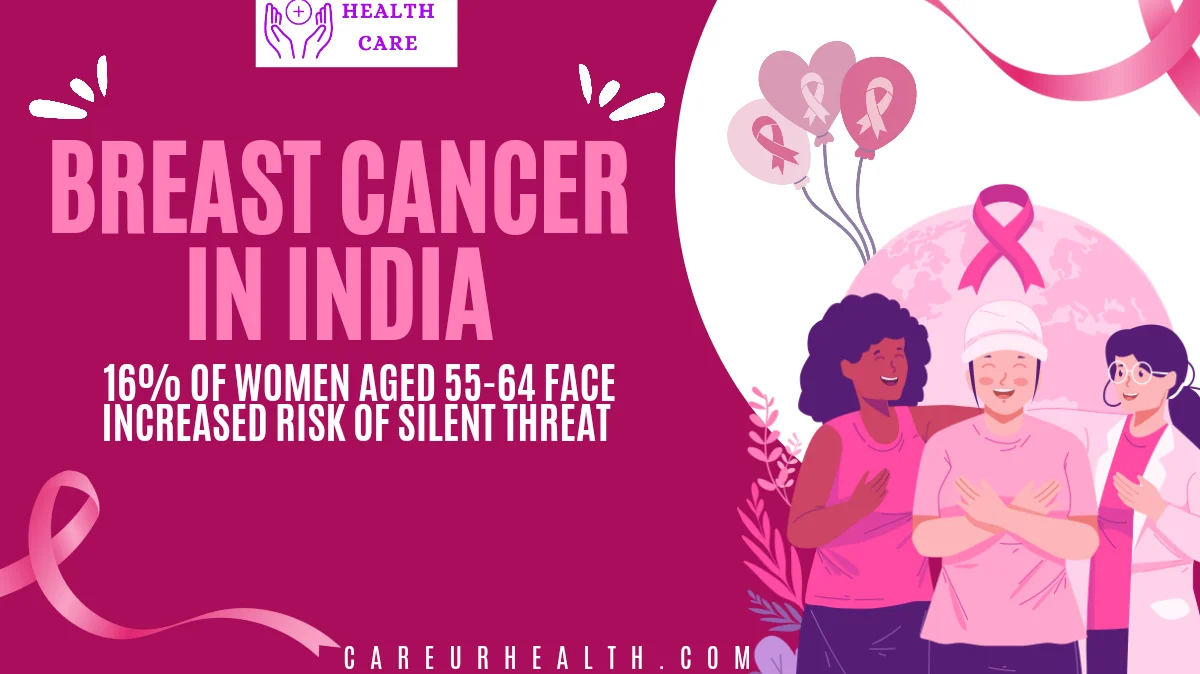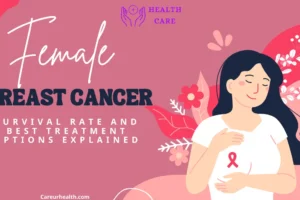Breast cancer cases in India have been on the rise in recent years. Breast cancer poses a silent yet growing threat to women in India, particularly affecting 16% of those aged 55-64. Early detection of breast cancer cases in India can improve survival rates.
This demographic shows a marked rise in risk as well as making awareness, early detection, and treatment critical. Rural areas are seeing a worrying rise in breast cancer cases in India.
Key Takeaways:
- 16% of women aged 55-64 in India face an elevated risk of breast cancer.
- The lack of awareness leads to delayed diagnosis, increasing mortality rates.
- Breast cancer is the most common cancer among women in India.
- Early detection through screening can significantly improve survival rates.
- Post-menopausal women are particularly vulnerable to developing the disease.
Understanding Breast Cancer in India
Breast Cancer: A Growing Concern
Breast cancer is now the most common form of cancer affecting women in India. Early detection of breast cancer cases in India can improve survival rates.
“The increased incidence of the disease has raised concerns, particularly among women aged 55-64, where 16% are at greater risk.”
Lifestyle changes, genetic factors, as well as late diagnosis contribute to the rising numbers.
Factors Leading to Increased Risk
Multiple factors put Indian women in this age group at heightened risk:
- Hormonal changes post-menopause increase susceptibility.
- Lack of routine screening results in late diagnosis.
- Genetic predisposition plays a role in some cases.
- Lifestyle choices such as diet and inactivity further compound the risk.
The Silent Threat: Delayed Diagnosis
Lack of Awareness
One of the primary reasons for breast cancer’s growing danger in India is the lack of awareness surrounding the disease. Breast cancer cases in India have been on the rise in recent years.
Women often overlook the initial symptoms, which leads to delayed diagnosis. Rural areas are seeing a worrying rise in breast cancer cases in India.
This “silent threat” quietly grows, only becoming evident when the cancer reaches an advanced stage. Early detection of breast cancer cases in India can improve survival rates.
- Many women are unaware of the symptoms to watch for, such as lumps or discharge.
- There is a cultural hesitation to discuss breast health openly.
- Late diagnosis significantly reduces survival rates.
- Rural areas have particularly low awareness, further increasing risk.
- Educational campaigns need to target this demographic effectively.
The Importance of Early Detection and Screening
Role of Screening
Early detection of breast cancer through screening significantly improves treatment outcomes. Mammograms are crucial in detecting the disease at an earlier as well as more treatable stage.
However, accessibility and affordability remain major issues in India, especially for women in lower-income brackets. Early detection of breast cancer cases in India can improve survival rates.
- Mammograms are essential for early detection, but not widely available.
- Screening programs are limited, especially in rural areas.
- Early detection can improve the five-year survival rate to nearly 90%.
- Mobile screening units can help bridge the gap in underserved areas.
- Efforts should focus on increasing public health infrastructure to make screenings accessible.
The Rising Risk for Indian Women
Breast cancer has emerged as a major public health concern in India. Early detection of breast cancer cases in India can improve survival rates.
Particularly alarming is the statistic that 16% of women aged 55-64 face an increased risk of developing breast cancer as well as representing a significant portion of the population.
With a higher number of cases being diagnosed in later stages, the need for awareness, early detection, as well as better treatment options is paramount. Breast cancer cases in India have been on the rise in recent years.
- The lack of screening programs in rural areas is contributing to late diagnoses.
- Post-menopausal women are at a particularly high risk.
- Hormonal changes during and after menopause increase the likelihood of cancer.
- Awareness programs targeting women over 50 are urgently needed.
- Family history is a crucial risk factor often overlooked in Indian households.
Risk Factors for Breast Cancer in Indian Women
Hormonal and Age-Related Factors
Women over the age of 55 experience significant hormonal changes that can influence the development of breast cancer. Early detection of breast cancer cases in India can improve survival rates.
With declining levels of estrogen, the body becomes more susceptible to abnormal cell growth in the breast tissue. Rural areas are seeing a worrying rise in breast cancer cases in India.
This risk is compounded by other factors, including family history, lifestyle, and genetics.
- Estrogen levels decrease sharply after menopause, increasing cancer risk.
- Late pregnancies and fewer childbirths have been linked to a rise in breast cancer cases.
- Women with a family history of breast cancer are more vulnerable.
- Obesity and sedentary lifestyles further heighten the risk.
- Hormone replacement therapy (HRT) may contribute to a higher cancer risk in some cases.
Genetic Predisposition and Family History
Genetics also play a vital role in the onset of breast cancer. Breast cancer cases in India have been on the rise in recent years.
- The presence of BRCA1/BRCA2 mutations can increase breast cancer risk by 80%.
- Screening for these mutations is available but not widely used in India.
- Early detection through genetic screening can save lives.
- Awareness of the importance of genetic testing is lacking.
The Silent Threat: Lack of Awareness and Late Diagnoses
Why Awareness is Crucial
One of the biggest challenges in India is the lack of public awareness surrounding breast cancer. Rural areas are seeing a worrying rise in breast cancer cases in India.
Many women, particularly in rural areas, are unfamiliar with the signs and symptoms, which leads to late diagnoses.
By the time cancer is detected, it has often reached an advanced stage, making treatment more difficult and reducing the chances of survival. Early detection of breast cancer cases in India can improve survival rates.
- Rural areas lack adequate healthcare infrastructure for early detection.
- Cultural stigma prevents many women from seeking medical help.
- Symptoms like lumps are often ignored as well as not recognized as a threat.
- Late diagnoses result in higher mortality rates among Indian women.
- Public campaigns are needed to educate women about the importance of screening.
Delayed Treatment and Consequences
The later breast cancer is diagnosed, the more difficult it becomes to treat. Indian women often experience long waiting periods between initial symptoms and diagnosis, which worsens their prognosis. Treatment options become limited as cancer spreads, and survival rates drop significantly.
- Chemotherapy and radiation are less effective in later stages.
- Surgery becomes more invasive, with options like mastectomy being necessary.
- The financial burden of late-stage cancer treatment is significantly higher.
- Late diagnosis leads to more physical and emotional trauma for patients.
- Mortality rates increase when breast cancer is detected in its later stages.
Read More:-How to Cure Breast Cancer Without Surgery: Exploring Alternative Treatments
Screening and Early Detection
The Importance of Mammography
Mammography remains the gold standard for early detection of breast cancer. Early detection of breast cancer cases in India can improve survival rates.
Breast cancer cases in India have been on the rise in recent years.
Women over the age of 50 should ideally undergo regular mammograms, but cultural, financial, as well as logistical barriers prevent many from doing so. Rural areas are seeing a worrying rise in breast cancer cases in India.
- Mammograms can detect tumors years before they become palpable.
- Early detection significantly improves the five-year survival rate.
- Mobile screening units can bring mammography services to underserved regions.
- Regular screening can catch the disease in its early, more treatable stages.
- Women should be educated about the importance of annual screening.
CK Birla Hospital
Lifestyle Changes and Prevention
Healthy Living as a Preventive Measure
While certain factors like age and genetics cannot be changed, other lifestyle adjustments can reduce the risk of developing breast cancer. Maintaining a healthy weight, eating a balanced diet, staying physically active, and reducing alcohol consumption are all steps that can be taken to lower the chances of getting breast cancer.
- Physical activity has been shown to reduce the risk of breast cancer.
- Maintaining a healthy weight is crucial for post-menopausal women.
- A diet rich in antioxidants and low in processed foods can reduce cancer risk.
- Limiting alcohol consumption lowers the likelihood of breast cancer.
- Avoiding smoking and managing stress are also important preventive measures.
Breast cancer continues to pose a serious threat to the health of women in India, especially those aged 55-64. Raising awareness, increasing accessibility to mammography, as well as promoting healthy lifestyle choices are crucial steps in reducing the disease’s impact.
With 16% of women in this age group at increased risk, there’s an urgent need for comprehensive health campaigns and policy changes to improve early detection and treatment outcomes. Early detection of breast cancer cases in India can improve survival rates.
Breast cancer cases in India have been on the rise in recent years. Timely intervention can save lives, as well as a united effort is essential to bring down breast cancer-related mortality rates in India.

Understanding the Silent Threat of Breast Cancer in India
The Growing Prevalence of Breast Cancer
Breast cancer has become one of the most common cancers affecting women in India. With increasing numbers diagnosed each year, the threat it poses has become more urgent.
This demographic is vulnerable due to factors like hormonal changes, lifestyle choices, and a lack of early screening. Early detection of breast cancer cases in India can improve survival rates.
Read More:–Tata memorial hospital and its cancer treatment and cost
Factors Contributing to Breast Cancer Risk
Several factors increase the likelihood of developing breast cancer, including genetics, age, and lifestyle. Women with a family history of breast cancer or specific gene mutations, such as BRCA1 as well as BRCA2, are at a higher risk. Moreover, the risk escalates after menopause due to significant hormonal changes.
In addition, unhealthy lifestyle choices, such as obesity, a lack of physical activity, and excessive alcohol consumption, contribute to this growing health crisis. Breast cancer cases in India have been on the rise in recent years.
Addressing these risk factors through early detection and promoting healthier lifestyle changes is critical in mitigating breast cancer’s impact on women in India. Rural areas are seeing a worrying rise in breast cancer cases in India.
The Importance of Early Detection and Screening
Unfortunately, in India, only a small percentage of women have access to mammography, especially in rural regions. Public health campaigns aimed at educating women about the importance of early screening are essential. The earlier breast cancer is detected, the greater the chances of successful treatment and improved survival outcomes.
Current Challenges in Breast Cancer Awareness
In rural communities, traditional beliefs often discourage discussions about cancer, making it a silent as well as growing threat. Increasing public awareness, improving access to healthcare, and encouraging women to engage in regular screening programs can drastically reduce the rate of late-stage breast cancer diagnoses in India.
Risk Factors for Post-Menopausal Women
Hormonal Changes and Breast Cancer Risk
Women aged 55-64 fall into the post-menopausal category, where hormonal changes drastically affect breast cancer risk. Breast cancer cases in India have been on the rise in recent years.
Lower levels of estrogen and progesterone play a significant role in increasing vulnerability. Early detection of breast cancer cases in India can improve survival rates.
- The post-menopausal period is characterized by declining hormones.
- Women in this age group often experience a higher incidence of breast tumors.
- Hormone replacement therapy (HRT) can sometimes further increase breast cancer risk.
- Regular screening during this period is critical for early diagnosis.
- Understanding the hormonal impact can help women take proactive preventive measures.
Treatment Options and Survival Rates
Advances in Treatment
Breast cancer treatment options have advanced considerably, leading to better survival rates. Treatments vary depending on the stage of cancer at diagnosis, but early-stage cancers have much higher survival rates.
- Surgery, radiation, and chemotherapy are common treatment options.
- Newer treatments, such as targeted therapy, focus on specific cancer cells. Rural areas are seeing a worrying rise in breast cancer cases in India.
- Survival rates for early-detected breast cancer are significantly higher.
- Access to quality healthcare is crucial for improving outcomes.
Conclusion
Breast cancer remains a serious threat to women’s health in India, especially for the 16% of women aged 55-64 who face increased risk. Early detection through screening, awareness programs, and accessible healthcare can drastically reduce mortality rates.
A concerted effort is necessary to ensure that more women receive timely diagnoses as well as proper treatment, ultimately saving lives.
FAQs
- What is the most common age group at risk for breast cancer in India?
Women aged 55-64 are at the highest risk of breast cancer in India. Breast cancer cases in India have been on the rise in recent years.
- Can early detection improve survival rates?
Yes, early detection can significantly improve survival rates, especially when cancer is caught in its initial stages.
- What are the main risk factors for breast cancer in post-menopausal women?
Post-menopausal women face increased risk due to hormonal changes, genetic factors, as well as lifestyle choices. Rural areas are seeing a worrying rise in breast cancer cases in India.
- Is mammography widely available in India?
Mammography is available in urban areas but limited in rural regions due to a lack of infrastructure.
- How can awareness of breast cancer be increased in India?
Public health campaigns, educational programs, and mobile screening units can improve awareness, particularly in underserved areas.










